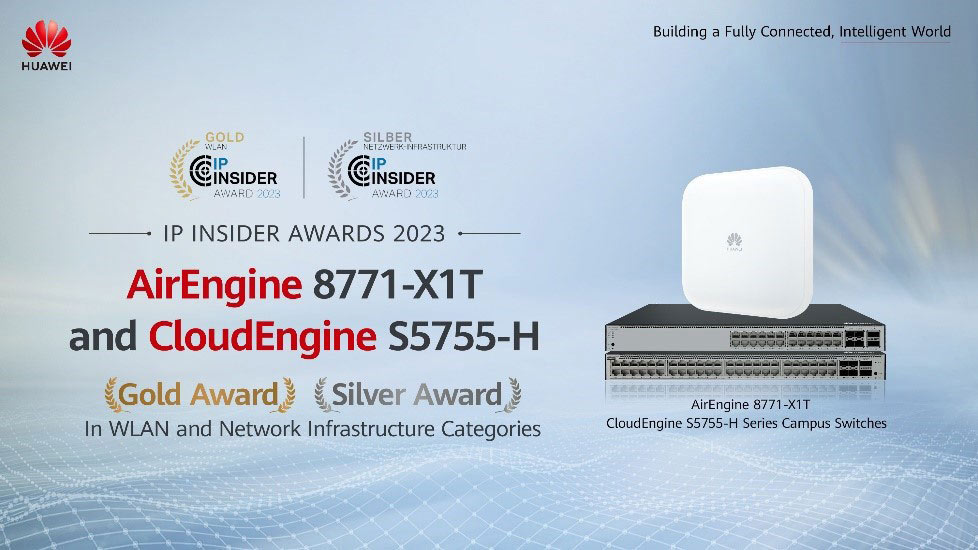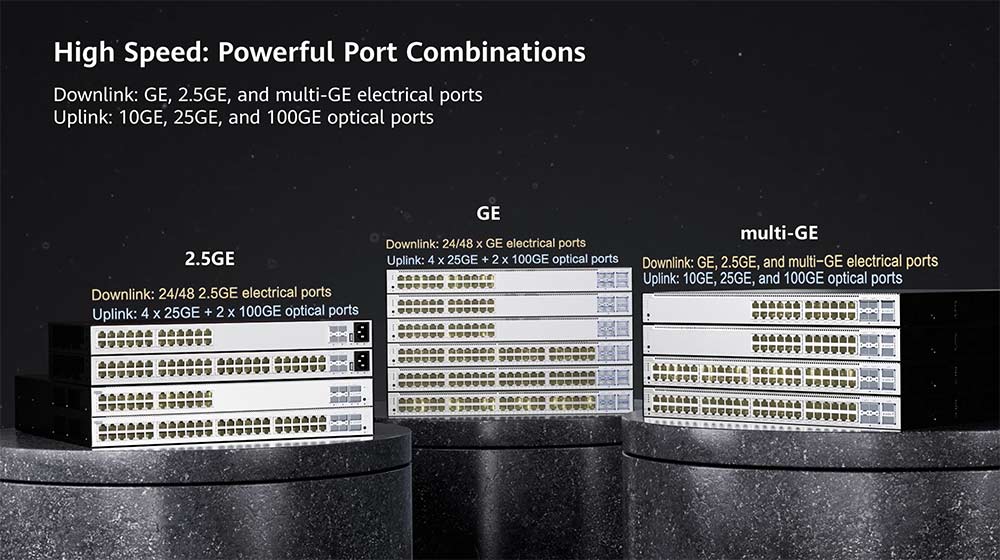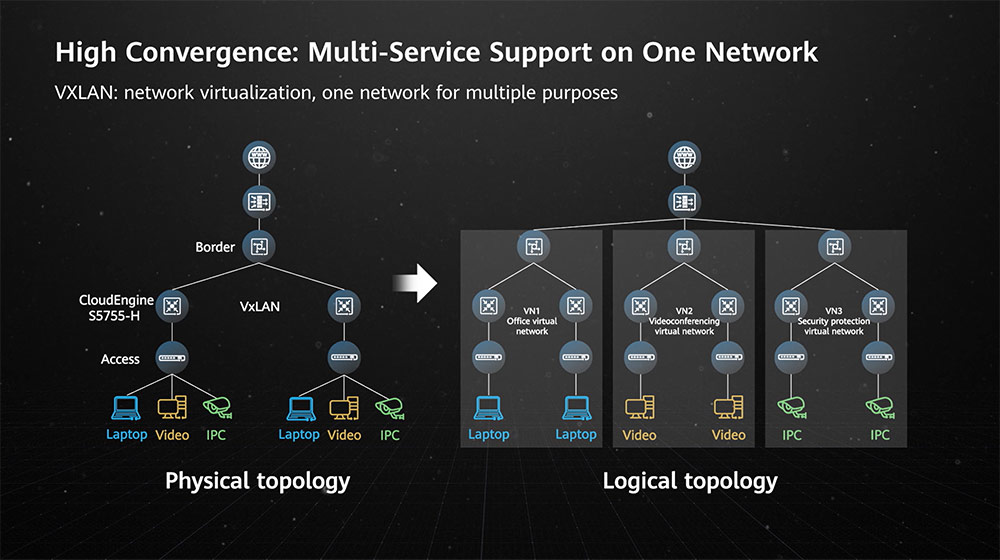Este sitio utiliza cookies. Si continúa navegando en este sitio, acepta nuestro uso de cookies. Lea nuestra política de privacidad>
![]()
Este sitio utiliza cookies. Si continúa navegando en este sitio, acepta nuestro uso de cookies. Lea nuestra política de privacidad>
![]()
Productos, soluciones y servicios empresariales
As Wi-Fi 7 approaches, network speeds are on the cusp of a huge breakthrough. This year, Huawei launched the industry's first commercial Wi-Fi 7 AP that achieves a record-high air interface rate of 18.67 Gbps and supports 120 channels of HD video. At Southeast University, a famous university in China, the actual tested single-terminal rate of Huawei Wi-Fi 7 AP reaches 4.3 Gbps, 2.5 times that of Wi-Fi 6. With the full release of network speeds, Wi-Fi 7 will unlock a variety of new applications and services.
Going forward, what kind of high-quality switches will we need to adapt to the changes in the digital world? Huawei CloudEngine S5755-H series switches, — which recently won a silver award of IP Insider Awards from Vogel IT, the largest media in Germany, — provide a choice for the high-quality future.

Global median network speeds for terminals are estimated to reach as high as 85.31 Mbps in 2023, and the bandwidth of about 10 users are likely to exceed gigabit speeds. Taking a complete ICT-based classroom as an example, the podium computer and 35 student tablets each require 30 Mbps bandwidth, and two channels of security video each require 20 Mbps bandwidth. All of these bandwidth demands have exceeded gigabit speeds. Coupled with various electronic teaching aids, administrative Internet access, and future-proof VR classrooms, the future classroom bandwidth will exceed 2000 Mbps.

However, 97% of ports in the current market are GE ports, and the actual tested network speed of Wi-Fi 7 mobile phones exceeds 4 Gbps. The uplink rate of APs will be 2.5 Gbps or more. Such a high uplink rate cannot be supported by today's GE switch ports at most enterprises. That's why the global shipment of multi-GE ports increases by 100% every year. Going ahead, the access network must be gradually upgraded from GE to 10GE.

When it comes to 10GE-capable multi-GE upgrades, enterprises still have many concerns:
• Cables cannot be reused: Currently, GE ports use CAT5 or CAT5E network cables, while 5GE and higher ports use CAT6 cables. Replacing legacy switches with 10GE-capable multi-GE switches means network-wide re-cabling.
• Incompatible with legacy terminals: The industry's multi-GE ports can be downward compatible to 100 Mbps at most. However, customer networks in education, healthcare, and other industries have many legacy terminals that use 10 Mbps lines like scanners, telephone lines, and mini-hosts. Multi-GE upgrade means changing terminals and existing services.
• High device costs: Expensive 10GE-capable multi-GE switches and the cost of replacing cables and terminals are beyond the reach of many enterprises.
Inadequate GE but expensive 10GE makes 2.5GE an excellent choice for the transition period. For example, many vendors such as Lenovo and HP have upgraded their mainboard ports from GE to 2.5GE to support their office bandwidth evolution. Huawei CloudEngine S5755-H series switches have three types: GE, 2.5GE, and 10GE-capable multi-GE. The 2.5GE ports are compatible with 10 Mbps and 100 Mbps legacy terminals, and can accommodate all the terminals on customer live networks without worrying about device unavailability after upgrading.
In addition, 2.5GE ports support CAT5E cables for GE ports, eliminating the need for re-cabling. It not only adapts to existing gigabit networks, but also provides higher-rate 2.5GE to terminals (high-performance PCs) and to rooms (connecting to APs) at no extra cost. Multi-GE models can switch from GE to 2.5GE, 5GE, and 10GE in different phases as needed. This can gradually support 10GE bandwidth growth and pave the way for flexible and smooth network evolution.

In terms of services, the high-speed Wi-Fi 7 will further unleash the digital productivity of enterprises with an ever-increasing variety of services. However, many enterprises use separate network devices for research and development (R&D), security, office, and guest networks. The coexistence of multiple networks greatly increases the network scale and complexity, making it difficult to evolve and expand. Meanwhile, network construction and management costs remain high.
CloudEngine S5755-H series switches support end-to-end network slicing and virtual extensible local area network (VXLAN). Different services are carried on a set of physical devices for centralized management, avoiding repeated network construction and investment. It also delivers intelligent differentiated services on demand, reserving and prioritizing resources for VIP users and services. In particular, slicing supports ultra-fine-grained division at a minimum of 1 Mbps. Even services as small as text file transfer can be guaranteed. In this way, each customer service can be flexibly matched with the best network resources, enabling unified management and secure isolation of services from all departments on one network.

The convenience offered by high-speed Wi-Fi 7 networks will further diversify enterprise services and migrate more enterprise services to the cloud. As most services are digitalized and automated, enterprise production will become increasingly network dependent. Take the semiconductor production line as an example. There are more than 1000 processes, and a large amount of data interaction between machines and servers. The hourly loss caused by interruptions to the production line can be as high as US$1 million.
In addition, Layer 2 information on the traditional Ethernet is transmitted in plain text, and the network cannot detect bogus and unauthorized devices, resulting in low information security. Enterprise networks require highly reliable access and robust information security. To achieve this, CloudEngine S5755-H series switches support up to three power supplies and fan modules in N+1 backup mode. The ultimate hardware redundancy design ensures that switches run stably and remain uninterrupted. At the software layer, Multichassis Link Aggregation Group (M-LAG) is supported to enable fault failover in seconds and automatic fault domain isolation. In addition, all ports support MACsec technology, which works with terminal fingerprint identification and traffic anomaly detection to achieve zero data leakage, zero forgery, and zero unauthorized access.

As Wi-Fi 7 approaches, many customers prefer and choose Huawei CloudEngine S5755-H series high-quality switches for their smooth bandwidth evolution, multi-service convergence, and reliable security. Huawei will work with customers in various industries to embrace high-quality future-proof campus networks.
Disclaimer: The views and opinions expressed in this article are those of the author and do not necessarily reflect the official policy, position, products, and technologies of Huawei Technologies Co., Ltd. If you need to learn more about the products and technologies of Huawei Technologies Co., Ltd., please visit our website at e.huawei.com or contact us.